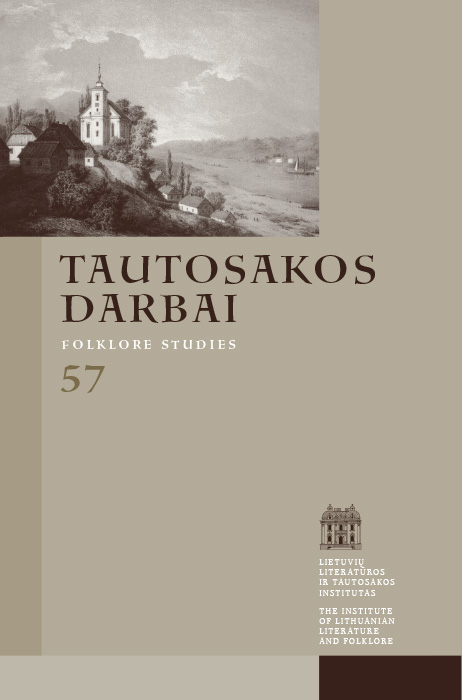Phenomenon of Popularity of the Lithuanian Folktale “The Sister as Duck”
Abstract
The Lithuanian folktale “The Sister as Duck” (AT 452C*), most commonly known under the name of “Sigutė”, is generally regarded as a popular narrative. It is appreciated for the rich mythical imagery: after the female protagonist is burned and the cow licks the ashes, the duck appears; the snow is allegedly sparkling because of the witch’s brains (bones) scattered there, etc. Moreover, the tale abounds in expressive song insertions.
This tale has been published both in academic and popular editions. Its images are widespread in popular culture, even becoming stereotypical. However, in the card file catalogue of the Lithuanian folk narratives, only 17 variants of this tale and 5 fragments recorded from oral tradition can be found.
By using contextual analysis, the author of the article attempts establishing when, how, and due to what circumstances this tale has turned into a phenomenon of popular culture.
Its first recording from oral tradition in the 19th century purported to serve as illustration of the peculiarities of a particular Lithuanian dialect. After the ban of the Lithuanian press in Latin alphabet was lifted in the beginning of the 20th century, this variant of the tale was included into a published collection of folktales for children, subsequently spreading to various schoolbooks, which commonly used it for didactic purposes, such as educating empathy in children.
During Soviet times, the tale found its way into several academic editions, afterwards crossing into popular folktales’ collections for children published in thousands of copies. The tale also became popular in audial shape: its sound recordings were published both in Lithuania and abroad.
The analysis of the tale’s variants recorded from the oral tradition highlighted certain characteristics indicating that its popularity must have depended on the written culture. In the five variants of the tale recorded in 1936–1959, the female protagonist is not once called Sigutė or turns into the duck. However, the eleven variants recorded in 1962–1980 include most of the structural components or certain peculiar details from the first published variant of the tale, e.g. the song insertions, the girl’s name, the duck motive. In most cases, the girl turns into duck here, and only once into a cuckoo. This testifies to the obvious influence of the published variant.
The folktale “Sigutė” earned phenomenal popularity also due to its artistic interpretations. In the beginning of the 20th century, it inspired works by such Lithuanian neo-romanticists as Vydūnas, Salomėja Nėris and others. During Soviet times, this story served as basis for plays and theater performances for children, thus further paving its way into popular culture.
The fate of the folktale “Sigutė” may be regarded as a certain case of folktale canon formation: the folk text originating in oral tradition is affected by instruments of the written culture, turning into a narrative of national renown and importance. Possibly such cannon formation was also determined by the decline of the traditional folk culture, as result of which the educated people selecting the folk texts to inspire their creativity particularly favored the ones characterized by a dramatic story line and impressive tragic developments, which therefore could be easily adapted into individual literary compositions.
Thus, the literary and musical interpretations of the folktale “Sigutė” have significantly added to its popularity, turning it into a canonic childhood text. Lacking popularity in the oral tradition and recorded as just a few fragmented variants, most likely retold from the published folktale collections, the folktale “Sigutė” became a special phenomenon of the written Lithuanian culture.
Downloads
Most read articles by the same author(s)
- Jūratė Šlekonytė, The Folktale Narrator at the Turn of the 20th – 21st Century: the Case of Antanina Čaplikienė from Subartonys , Tautosakos darbai: Vol. 64 (2022)
- Jūratė Šlekonytė, Lithuanian Fairy Tale “Bearskin” (ATU 361): European Context and Local Peculiarities , Tautosakos darbai: Vol. 66 (2023): Tautosakos darbai
- Jūratė Šlekonytė, Women Storytellers and Peculiarities of Their Repertoire , Tautosakos darbai: Vol. 67 (2024): Tautosakos darbai
- Jūratė Šlekonytė, A Hundred Years of the Lithuanian Folktale Research: from the Traditional Comparativism to the Modern Methods , Tautosakos darbai: Vol. 49 (2015)
- Jūratė Šlekonytė, August Schleicher as the First Publisher of Lithuanian Folktales , Tautosakos darbai: Vol. 61 (2021)
- Jūratė Šlekonytė, A New Book on Wondertale Symbolism , Tautosakos darbai: Vol. 67 (2024): Tautosakos darbai
- Jūratė Šlekonytė, The First Volumes of the Fundamental Edition of the Czech Folktales , Tautosakos darbai: Vol. 64 (2022)
- Vita Džekčioriūtė, Aušra Žičkienė, Jūratė Šlekonytė, Gražina Kadžytė, Jurgita Ūsaitytė, Lina Būgienė, Daiva Vyčinienė, Chronicle , Tautosakos darbai: Vol. 48 (2014)
- Jūratė Šlekonytė, The Lithuanian Legends of the Wild Hunt: Regarding Origins of the Image , Tautosakos darbai: Vol. 47 (2014)
- Jūratė Šlekonytė, Do We Need Folktales? Bruno Bettelheim Answering , Tautosakos darbai: Vol. 55 (2018)
